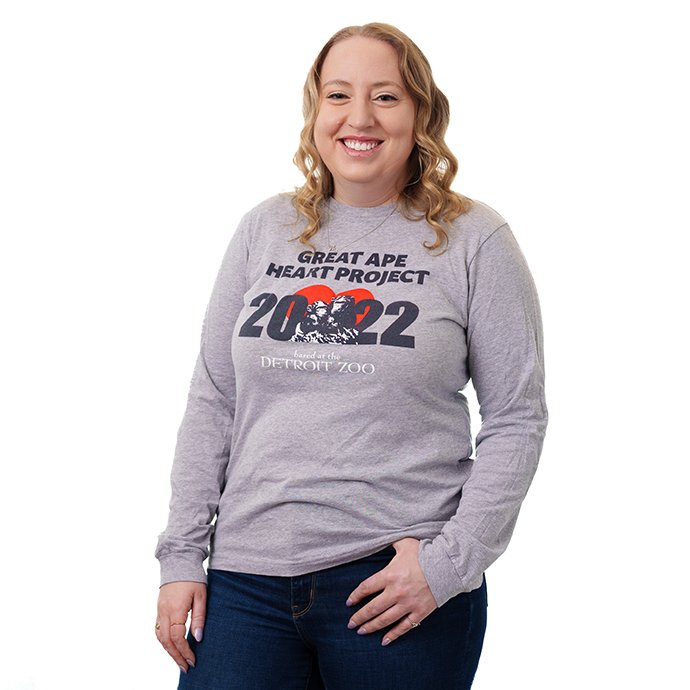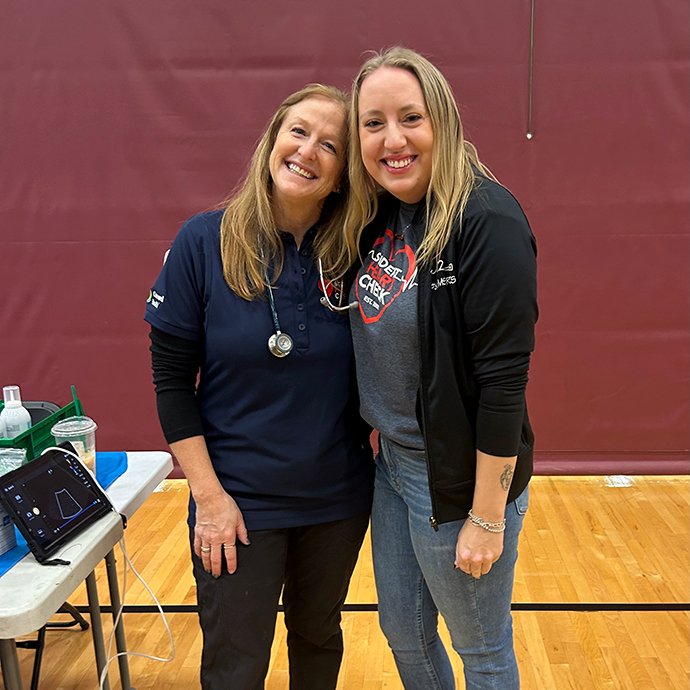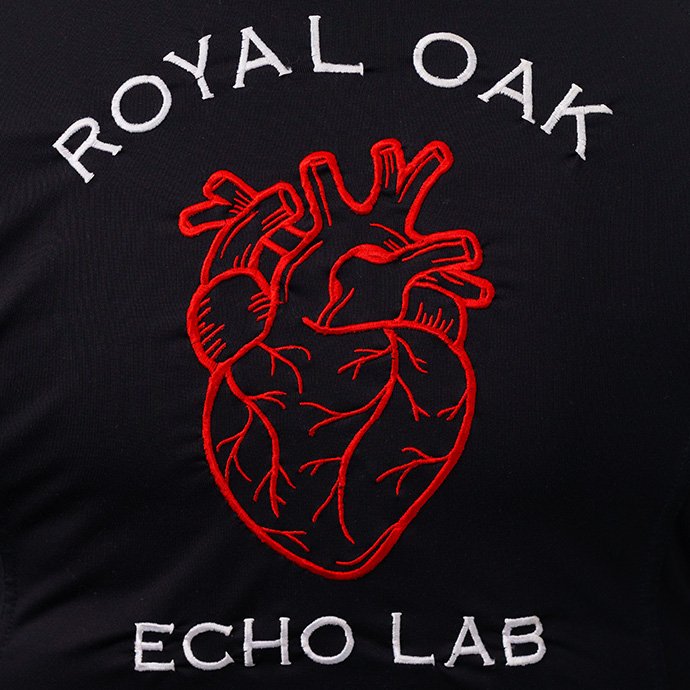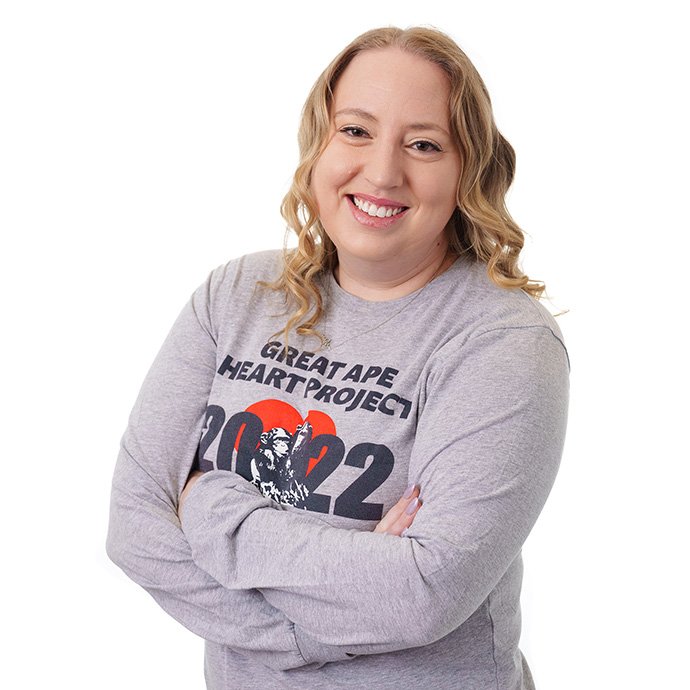A rhythmic “swish-swish” fills the room as detailed images from an echocardiogram are captured and analyzed by Lesley Sleeman, SHS ’13 and ’16. Though the procedure is part of her daily routine as a cardiac sonographer at Corewell Health William Beaumont Hospital University, this particular echo is unique for Sleeman, as she stands among a team of doctors and veterinarians at the Detroit Zoo. Her patient is a 500lb silverback gorilla.
“I work with humans and I am a huge animal lover, but I never thought that those worlds would collide,” Sleeman says. “It is super surreal for me to be in there and scanning this huge gorilla. They’re just beautiful animals to see up close like that.”
As a volunteer with the Great Ape Heart Project (GAHP), Sleeman utilizes her skills in sonography to help monitor the cardiac health of local great apes. The GAHP, housed in the Detroit Zoo, is a group of cardiac experts that aids in understanding and treatment of cardiac disease in great apes.
A Long Road
 |
Sleeman’s path to a cardiac career — helping both humans and apes — was inspired by her own health journey.
At a young age, Sleeman was overcome with debilitating symptoms when a virus damaged her inner ear function. Even with two years of intense physical therapy, Sleeman struggled to maintain her health and withdrew from high school. She returned once her symptoms were manageable, but it would take her six years to obtain her high school diploma. The damage from the virus was eventually partially recovered but left Sleeman with permanent damage in one side of her ears. Her journey back to health, however, was far from over. “I was left with all these other issues,” she says. “I went everywhere to try to figure it out and was put on multiple different medications, but it was just trying to treat the symptoms without knowing what the problem actually was.”
For nearly 10 years, Sleeman endured chronic fatigue, nausea and dizziness. Relentlessly determined, she decided to pursue an education at Oakland University. Once on campus, though, Sleeman was struggling to keep up with her classes and registered with Disability Support Services to help provide the support she needed to persevere.
 |
| Lesley Sleeman (right) with Ilana Kutinsky |
“I remember I had a really bad vertigo episode and I had to miss this exam,” Sleeman says. “Because of the Disability Support Services, I received more time on the exam and I was able to finish it at a later date.”
During her undergraduate studies, Sleeman was diagnosed with dysautonomia and POTS. Relieved to finally be able to properly manage her health, Sleeman started seeing cardiologist Ilana Kutinsky, D.O.; a fateful encounter that laid the groundwork for her future career, finding her career path in cardiology.
After graduating from Oakland University with a bachelor’s in health science and a master’s in exercise science, Sleeman began working as a sonographer at Corewell Health William Beaumont Hospital University,building her skills and learning from the cardiologist that helped her manage her illness. “Flash forward to six years ago when I started working as a cardiac sonographer, and I now get to work with her [Dr. Kutinsky] during certain procedures in the hospital.”
“It’s just amazing to see the work that [the Great Ape Heart Project] does and the care that they take for these animals.”
Lesley Sleeman, SHS '13 and '16

Adobe Stock
Great Ape Heart Project (GAHP)
It wasn’t long before Sleeman learned about the GAHP and was compelled to volunteer her talents. “Dr. Kutinsky is one of the founders of the Great Ape Heart project,” Sleeman says. “This work is amazing. When their other sonographer was retiring, Dr. Kutinsky entrusted me to jump in.”
According to a study published in the Journal of American Society of Echocardiography, heart disease is the main cause of death for great apes in captivity. Thanks to the GAHP, this critical need for cardiac care in great apes is being addressed through routine assessments that are logged into a centralized database. Zoos and sanctuaries across the world can utilize this data to analyze, report and coordinate cardiac-related research in an attempt to better support the health of great apes.
“It’s just amazing to see the work that they do and the care that they take for these animals,” explains Sleeman. “What’s wild is that it’s the same as a human.”
 |
The cardiac assessments vary per animal, depending on age and health. Once the team has scheduled an exam, the ape is administered anesthesia before being safely moved to the zoo’s on-site hospital. There is an extensive team of medical and zoo staff in the room monitoring the patient’s care — from an anesthesiologist and veterinarians to the primate handlers and sonographer. In a standard echo, Sleeman checks all the chambers to see if the valves are leaking, and examines how the heart muscles move and the overall cardiac function. While there are significant similarities between the great ape’s heart and the human heart, there are some challenges unique to primates.
“For the echo, it is super interesting because typically we turn someone on their left side so that the heart is positioned a bit closer to the ultrasound probe,” says Sleeman. “I was struggling, though, to get images on one of the gorillas, and trying to turn it on its side took multiple people to maneuver.”
Another time, Sleeman ran into a different challenge when her expertise was requested at the Toledo Zoo for a cardiac exam on a male orangutan. Male orangutans have a large throat air sac that amplifies the sound of their calls. Since the sac hangs over the chest, it makes capturing a good read more difficult.
 |
“When I scanned him, instead of feeling bone, I felt like I was scanning on Jello,” recalls Sleeman. “I had to push all the way down and move their air sacs because I can’t get an image otherwise.”
Over the past four years, Sleeman has assisted in the cardiac health of orangutans, gorillas and chimpanzees. The work she does alongside other heart experts in the GAHP is providing vital care and data that will benefit great apes worldwide. “It’s increasing the lifespan of these animals and the quality of their lives,” Sleeman says.
Looking back, Sleeman knows it took her own experience with health challenges to help improve the lives of others. “Because of my illness, I met Dr. Kutinsky. From there I chose to be a sonographer. And because of both those things, I became involved in the GAHP,” she continues. “It is really a full-circle moment.”
More Like This: |

 April 2, 2025
April 2, 2025 By Kelli M. Warshefski
By Kelli M. Warshefski







